Environmental Impact Assessment of Emirates Airline's Operations
VerifiedAdded on 2023/04/10
|15
|2565
|474
Report
AI Summary
This report presents an environmental impact assessment of aircraft maintenance operations at Emirates Airline, focusing on the impact on water quality, waste management, and the effectiveness of mitigation measures. The study examines various activities, including the disposal of pollutants, and highlights the challenges associated with hazardous waste management. It details the mitigation measures implemented by Emirates, such as the use of retention ponds and dry washing techniques, to reduce environmental impact. The report also explores control measures and safety procedures in case of chemical spillages, providing a comprehensive overview of Emirates' commitment to environmental sustainability. Furthermore, the study evaluates the effectiveness of the mitigation measures, including the performance of discharge ponds and the impact on aquatic life, supported by statistical data and graphical analysis, demonstrating the airline's efforts to minimize its environmental footprint.
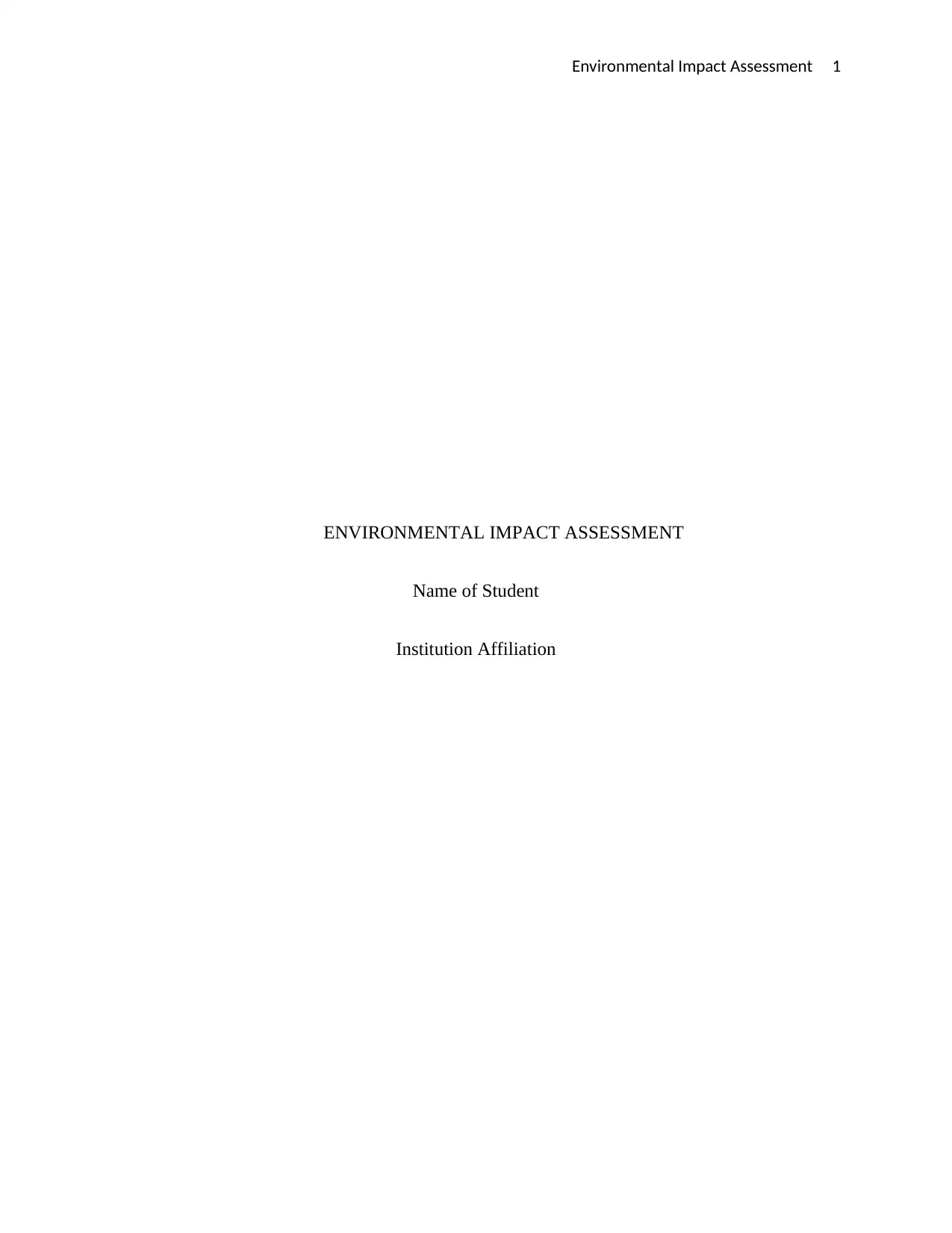
Environmental Impact Assessment 1
ENVIRONMENTAL IMPACT ASSESSMENT
Name of Student
Institution Affiliation
ENVIRONMENTAL IMPACT ASSESSMENT
Name of Student
Institution Affiliation
Paraphrase This Document
Need a fresh take? Get an instant paraphrase of this document with our AI Paraphraser
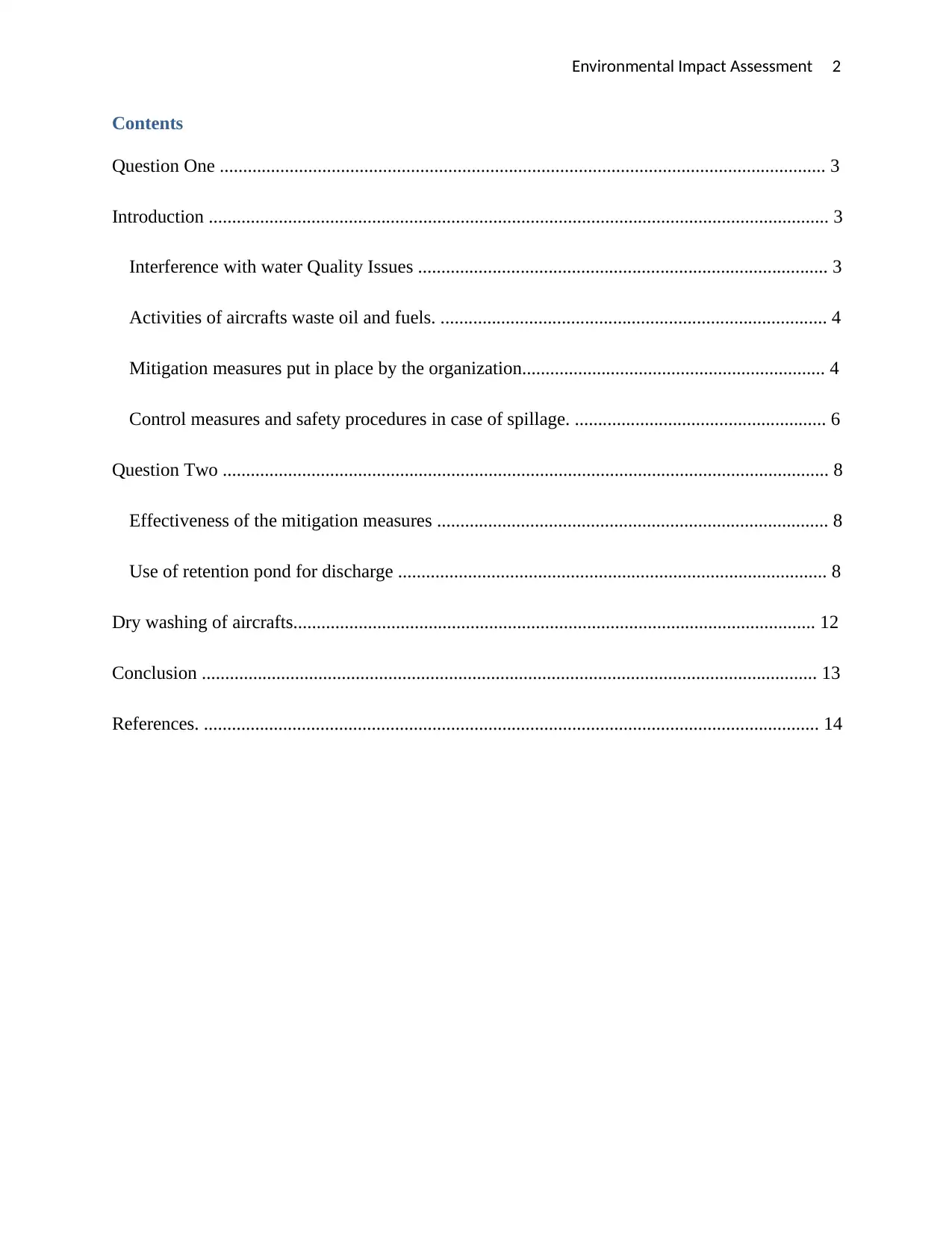
Environmental Impact Assessment 2
Contents
Question One .................................................................................................................................. 3
Introduction ..................................................................................................................................... 3
Interference with water Quality Issues ........................................................................................ 3
Activities of aircrafts waste oil and fuels. ................................................................................... 4
Mitigation measures put in place by the organization................................................................. 4
Control measures and safety procedures in case of spillage. ...................................................... 6
Question Two .................................................................................................................................. 8
Effectiveness of the mitigation measures .................................................................................... 8
Use of retention pond for discharge ............................................................................................ 8
Dry washing of aircrafts................................................................................................................ 12
Conclusion .................................................................................................................................... 13
References. .................................................................................................................................... 14
Contents
Question One .................................................................................................................................. 3
Introduction ..................................................................................................................................... 3
Interference with water Quality Issues ........................................................................................ 3
Activities of aircrafts waste oil and fuels. ................................................................................... 4
Mitigation measures put in place by the organization................................................................. 4
Control measures and safety procedures in case of spillage. ...................................................... 6
Question Two .................................................................................................................................. 8
Effectiveness of the mitigation measures .................................................................................... 8
Use of retention pond for discharge ............................................................................................ 8
Dry washing of aircrafts................................................................................................................ 12
Conclusion .................................................................................................................................... 13
References. .................................................................................................................................... 14
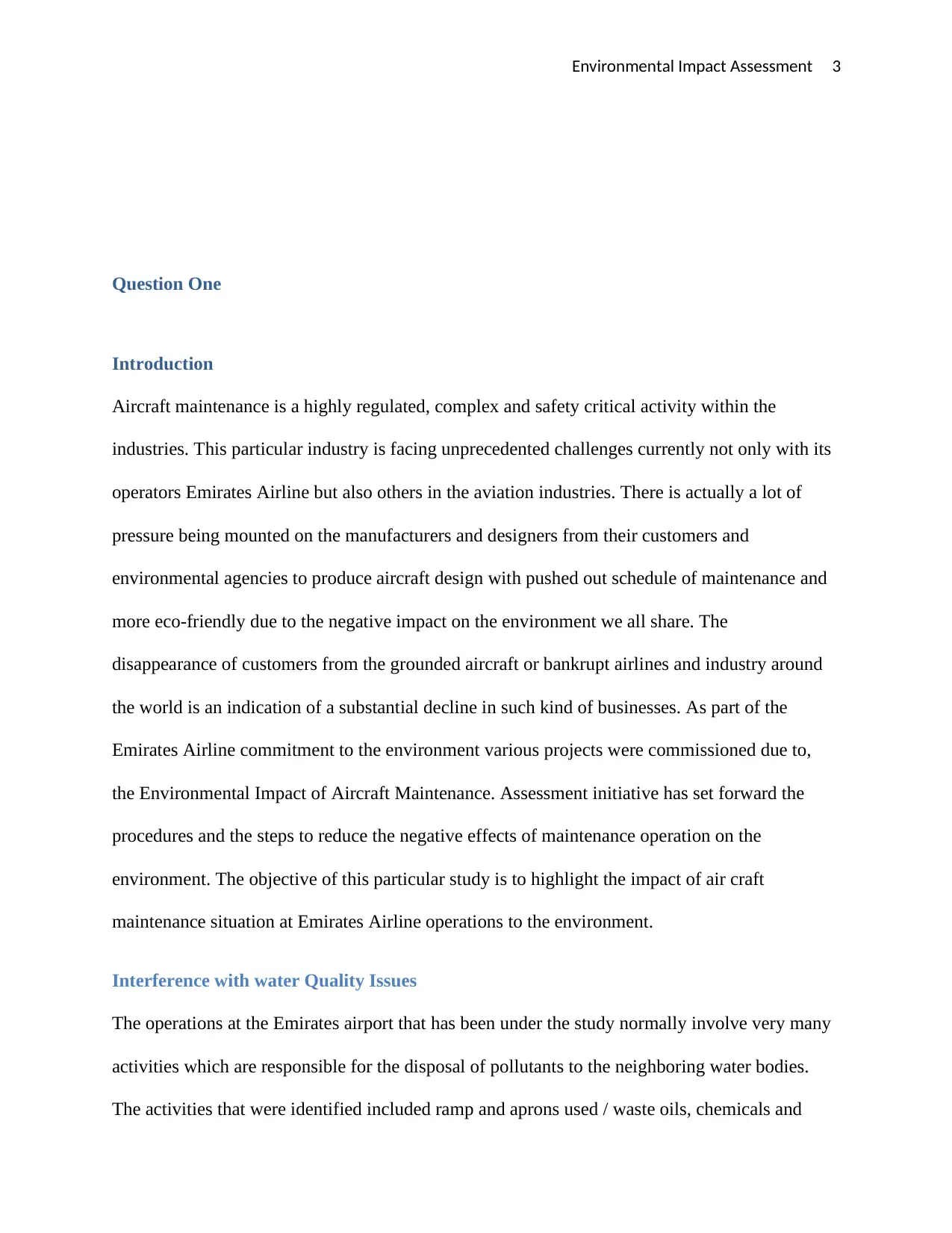
Environmental Impact Assessment 3
Question One
Introduction
Aircraft maintenance is a highly regulated, complex and safety critical activity within the
industries. This particular industry is facing unprecedented challenges currently not only with its
operators Emirates Airline but also others in the aviation industries. There is actually a lot of
pressure being mounted on the manufacturers and designers from their customers and
environmental agencies to produce aircraft design with pushed out schedule of maintenance and
more eco-friendly due to the negative impact on the environment we all share. The
disappearance of customers from the grounded aircraft or bankrupt airlines and industry around
the world is an indication of a substantial decline in such kind of businesses. As part of the
Emirates Airline commitment to the environment various projects were commissioned due to,
the Environmental Impact of Aircraft Maintenance. Assessment initiative has set forward the
procedures and the steps to reduce the negative effects of maintenance operation on the
environment. The objective of this particular study is to highlight the impact of air craft
maintenance situation at Emirates Airline operations to the environment.
Interference with water Quality Issues
The operations at the Emirates airport that has been under the study normally involve very many
activities which are responsible for the disposal of pollutants to the neighboring water bodies.
The activities that were identified included ramp and aprons used / waste oils, chemicals and
Question One
Introduction
Aircraft maintenance is a highly regulated, complex and safety critical activity within the
industries. This particular industry is facing unprecedented challenges currently not only with its
operators Emirates Airline but also others in the aviation industries. There is actually a lot of
pressure being mounted on the manufacturers and designers from their customers and
environmental agencies to produce aircraft design with pushed out schedule of maintenance and
more eco-friendly due to the negative impact on the environment we all share. The
disappearance of customers from the grounded aircraft or bankrupt airlines and industry around
the world is an indication of a substantial decline in such kind of businesses. As part of the
Emirates Airline commitment to the environment various projects were commissioned due to,
the Environmental Impact of Aircraft Maintenance. Assessment initiative has set forward the
procedures and the steps to reduce the negative effects of maintenance operation on the
environment. The objective of this particular study is to highlight the impact of air craft
maintenance situation at Emirates Airline operations to the environment.
Interference with water Quality Issues
The operations at the Emirates airport that has been under the study normally involve very many
activities which are responsible for the disposal of pollutants to the neighboring water bodies.
The activities that were identified included ramp and aprons used / waste oils, chemicals and
⊘ This is a preview!⊘
Do you want full access?
Subscribe today to unlock all pages.

Trusted by 1+ million students worldwide
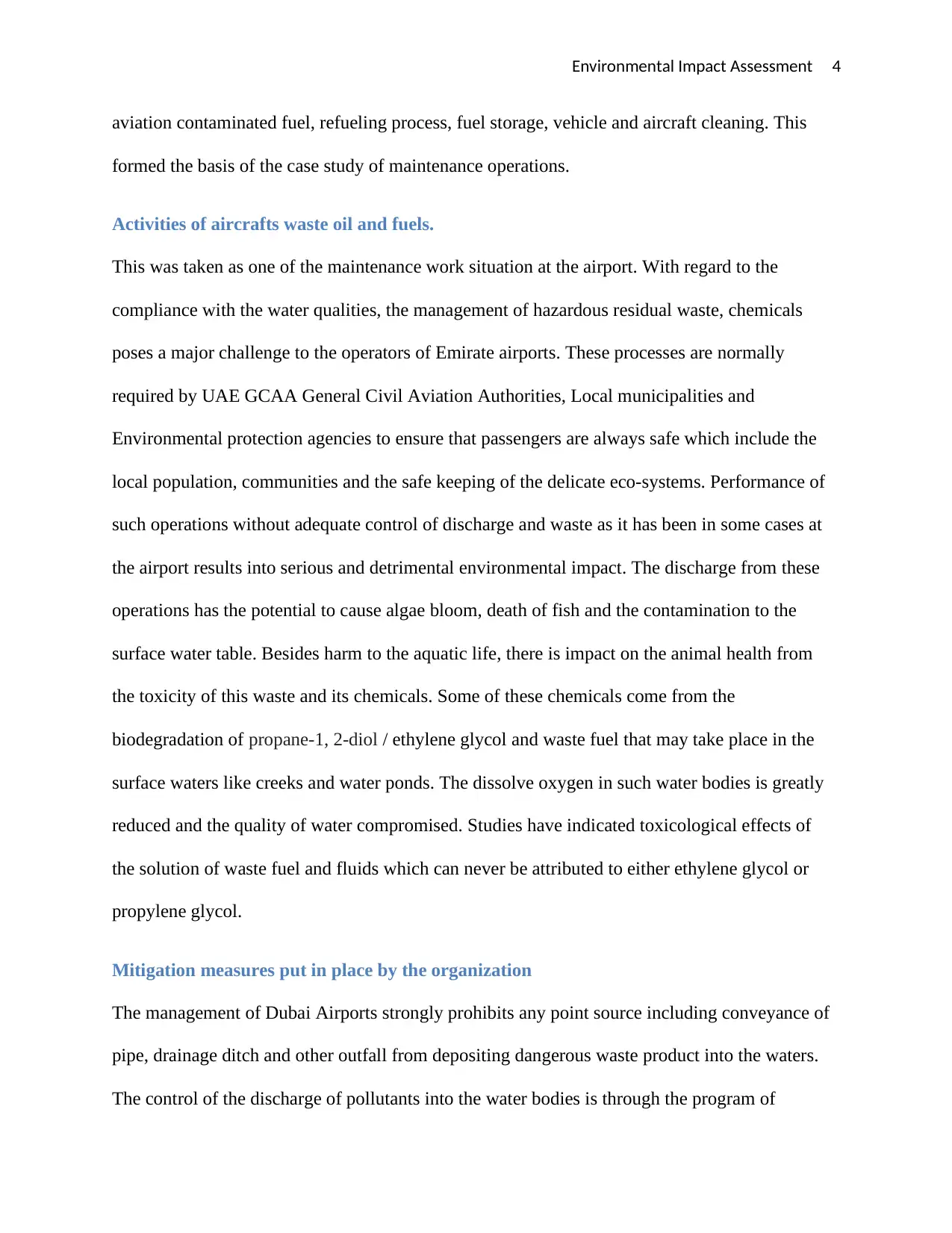
Environmental Impact Assessment 4
aviation contaminated fuel, refueling process, fuel storage, vehicle and aircraft cleaning. This
formed the basis of the case study of maintenance operations.
Activities of aircrafts waste oil and fuels.
This was taken as one of the maintenance work situation at the airport. With regard to the
compliance with the water qualities, the management of hazardous residual waste, chemicals
poses a major challenge to the operators of Emirate airports. These processes are normally
required by UAE GCAA General Civil Aviation Authorities, Local municipalities and
Environmental protection agencies to ensure that passengers are always safe which include the
local population, communities and the safe keeping of the delicate eco-systems. Performance of
such operations without adequate control of discharge and waste as it has been in some cases at
the airport results into serious and detrimental environmental impact. The discharge from these
operations has the potential to cause algae bloom, death of fish and the contamination to the
surface water table. Besides harm to the aquatic life, there is impact on the animal health from
the toxicity of this waste and its chemicals. Some of these chemicals come from the
biodegradation of propane-1, 2-diol / ethylene glycol and waste fuel that may take place in the
surface waters like creeks and water ponds. The dissolve oxygen in such water bodies is greatly
reduced and the quality of water compromised. Studies have indicated toxicological effects of
the solution of waste fuel and fluids which can never be attributed to either ethylene glycol or
propylene glycol.
Mitigation measures put in place by the organization
The management of Dubai Airports strongly prohibits any point source including conveyance of
pipe, drainage ditch and other outfall from depositing dangerous waste product into the waters.
The control of the discharge of pollutants into the water bodies is through the program of
aviation contaminated fuel, refueling process, fuel storage, vehicle and aircraft cleaning. This
formed the basis of the case study of maintenance operations.
Activities of aircrafts waste oil and fuels.
This was taken as one of the maintenance work situation at the airport. With regard to the
compliance with the water qualities, the management of hazardous residual waste, chemicals
poses a major challenge to the operators of Emirate airports. These processes are normally
required by UAE GCAA General Civil Aviation Authorities, Local municipalities and
Environmental protection agencies to ensure that passengers are always safe which include the
local population, communities and the safe keeping of the delicate eco-systems. Performance of
such operations without adequate control of discharge and waste as it has been in some cases at
the airport results into serious and detrimental environmental impact. The discharge from these
operations has the potential to cause algae bloom, death of fish and the contamination to the
surface water table. Besides harm to the aquatic life, there is impact on the animal health from
the toxicity of this waste and its chemicals. Some of these chemicals come from the
biodegradation of propane-1, 2-diol / ethylene glycol and waste fuel that may take place in the
surface waters like creeks and water ponds. The dissolve oxygen in such water bodies is greatly
reduced and the quality of water compromised. Studies have indicated toxicological effects of
the solution of waste fuel and fluids which can never be attributed to either ethylene glycol or
propylene glycol.
Mitigation measures put in place by the organization
The management of Dubai Airports strongly prohibits any point source including conveyance of
pipe, drainage ditch and other outfall from depositing dangerous waste product into the waters.
The control of the discharge of pollutants into the water bodies is through the program of
Paraphrase This Document
Need a fresh take? Get an instant paraphrase of this document with our AI Paraphraser
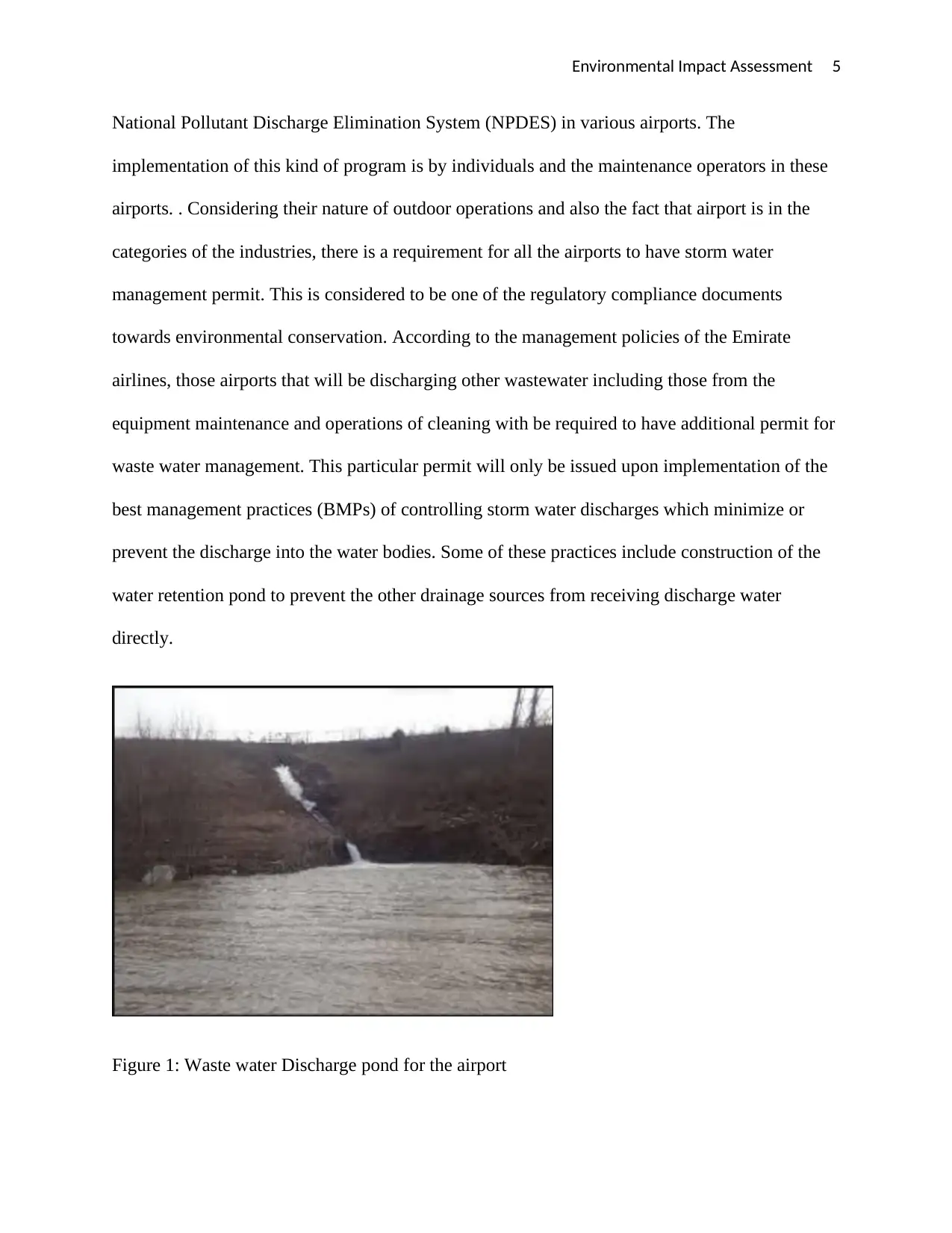
Environmental Impact Assessment 5
National Pollutant Discharge Elimination System (NPDES) in various airports. The
implementation of this kind of program is by individuals and the maintenance operators in these
airports. . Considering their nature of outdoor operations and also the fact that airport is in the
categories of the industries, there is a requirement for all the airports to have storm water
management permit. This is considered to be one of the regulatory compliance documents
towards environmental conservation. According to the management policies of the Emirate
airlines, those airports that will be discharging other wastewater including those from the
equipment maintenance and operations of cleaning with be required to have additional permit for
waste water management. This particular permit will only be issued upon implementation of the
best management practices (BMPs) of controlling storm water discharges which minimize or
prevent the discharge into the water bodies. Some of these practices include construction of the
water retention pond to prevent the other drainage sources from receiving discharge water
directly.
Figure 1: Waste water Discharge pond for the airport
National Pollutant Discharge Elimination System (NPDES) in various airports. The
implementation of this kind of program is by individuals and the maintenance operators in these
airports. . Considering their nature of outdoor operations and also the fact that airport is in the
categories of the industries, there is a requirement for all the airports to have storm water
management permit. This is considered to be one of the regulatory compliance documents
towards environmental conservation. According to the management policies of the Emirate
airlines, those airports that will be discharging other wastewater including those from the
equipment maintenance and operations of cleaning with be required to have additional permit for
waste water management. This particular permit will only be issued upon implementation of the
best management practices (BMPs) of controlling storm water discharges which minimize or
prevent the discharge into the water bodies. Some of these practices include construction of the
water retention pond to prevent the other drainage sources from receiving discharge water
directly.
Figure 1: Waste water Discharge pond for the airport
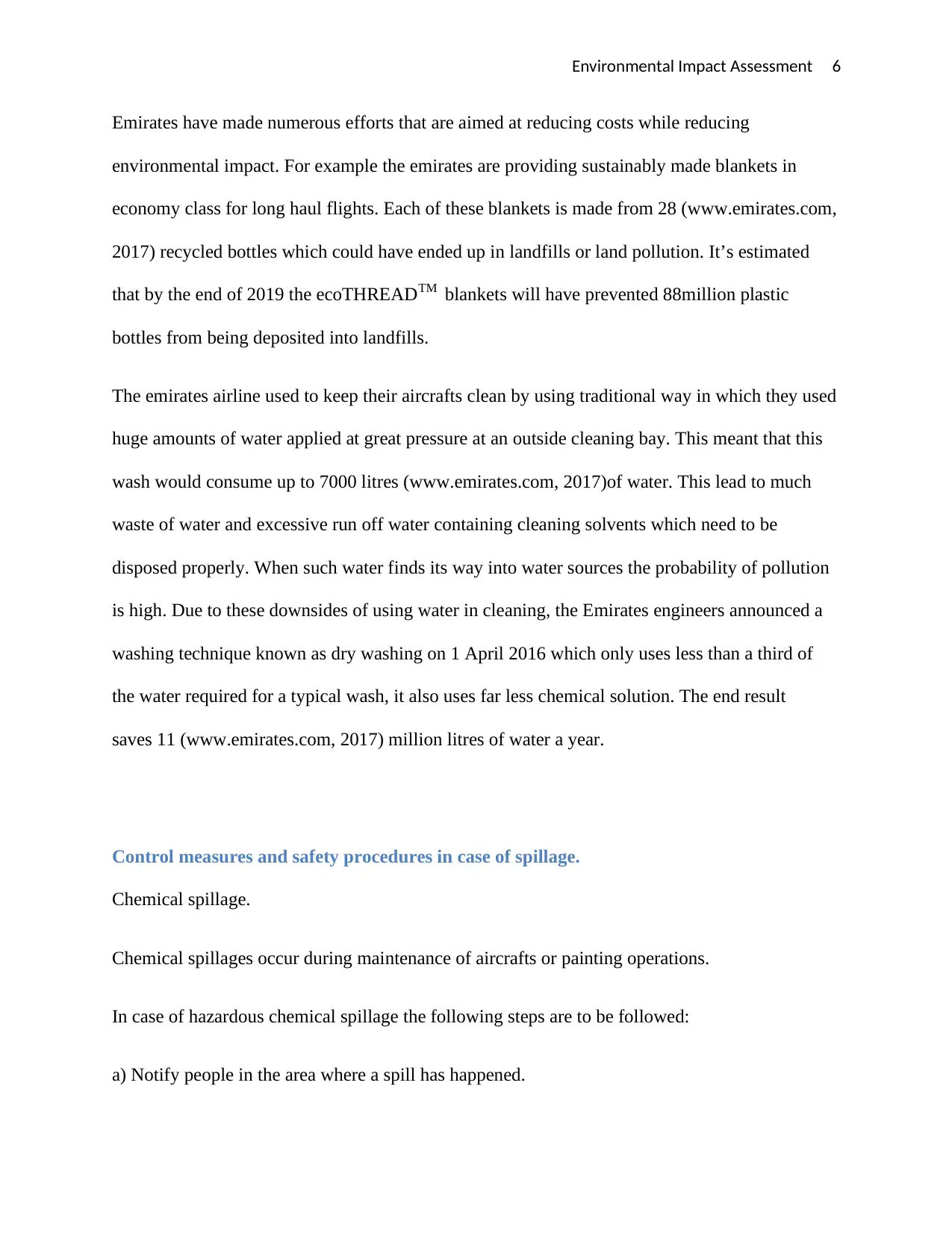
Environmental Impact Assessment 6
Emirates have made numerous efforts that are aimed at reducing costs while reducing
environmental impact. For example the emirates are providing sustainably made blankets in
economy class for long haul flights. Each of these blankets is made from 28 (www.emirates.com,
2017) recycled bottles which could have ended up in landfills or land pollution. It’s estimated
that by the end of 2019 the ecoTHREADTM blankets will have prevented 88million plastic
bottles from being deposited into landfills.
The emirates airline used to keep their aircrafts clean by using traditional way in which they used
huge amounts of water applied at great pressure at an outside cleaning bay. This meant that this
wash would consume up to 7000 litres (www.emirates.com, 2017)of water. This lead to much
waste of water and excessive run off water containing cleaning solvents which need to be
disposed properly. When such water finds its way into water sources the probability of pollution
is high. Due to these downsides of using water in cleaning, the Emirates engineers announced a
washing technique known as dry washing on 1 April 2016 which only uses less than a third of
the water required for a typical wash, it also uses far less chemical solution. The end result
saves 11 (www.emirates.com, 2017) million litres of water a year.
Control measures and safety procedures in case of spillage.
Chemical spillage.
Chemical spillages occur during maintenance of aircrafts or painting operations.
In case of hazardous chemical spillage the following steps are to be followed:
a) Notify people in the area where a spill has happened.
Emirates have made numerous efforts that are aimed at reducing costs while reducing
environmental impact. For example the emirates are providing sustainably made blankets in
economy class for long haul flights. Each of these blankets is made from 28 (www.emirates.com,
2017) recycled bottles which could have ended up in landfills or land pollution. It’s estimated
that by the end of 2019 the ecoTHREADTM blankets will have prevented 88million plastic
bottles from being deposited into landfills.
The emirates airline used to keep their aircrafts clean by using traditional way in which they used
huge amounts of water applied at great pressure at an outside cleaning bay. This meant that this
wash would consume up to 7000 litres (www.emirates.com, 2017)of water. This lead to much
waste of water and excessive run off water containing cleaning solvents which need to be
disposed properly. When such water finds its way into water sources the probability of pollution
is high. Due to these downsides of using water in cleaning, the Emirates engineers announced a
washing technique known as dry washing on 1 April 2016 which only uses less than a third of
the water required for a typical wash, it also uses far less chemical solution. The end result
saves 11 (www.emirates.com, 2017) million litres of water a year.
Control measures and safety procedures in case of spillage.
Chemical spillage.
Chemical spillages occur during maintenance of aircrafts or painting operations.
In case of hazardous chemical spillage the following steps are to be followed:
a) Notify people in the area where a spill has happened.
⊘ This is a preview!⊘
Do you want full access?
Subscribe today to unlock all pages.

Trusted by 1+ million students worldwide
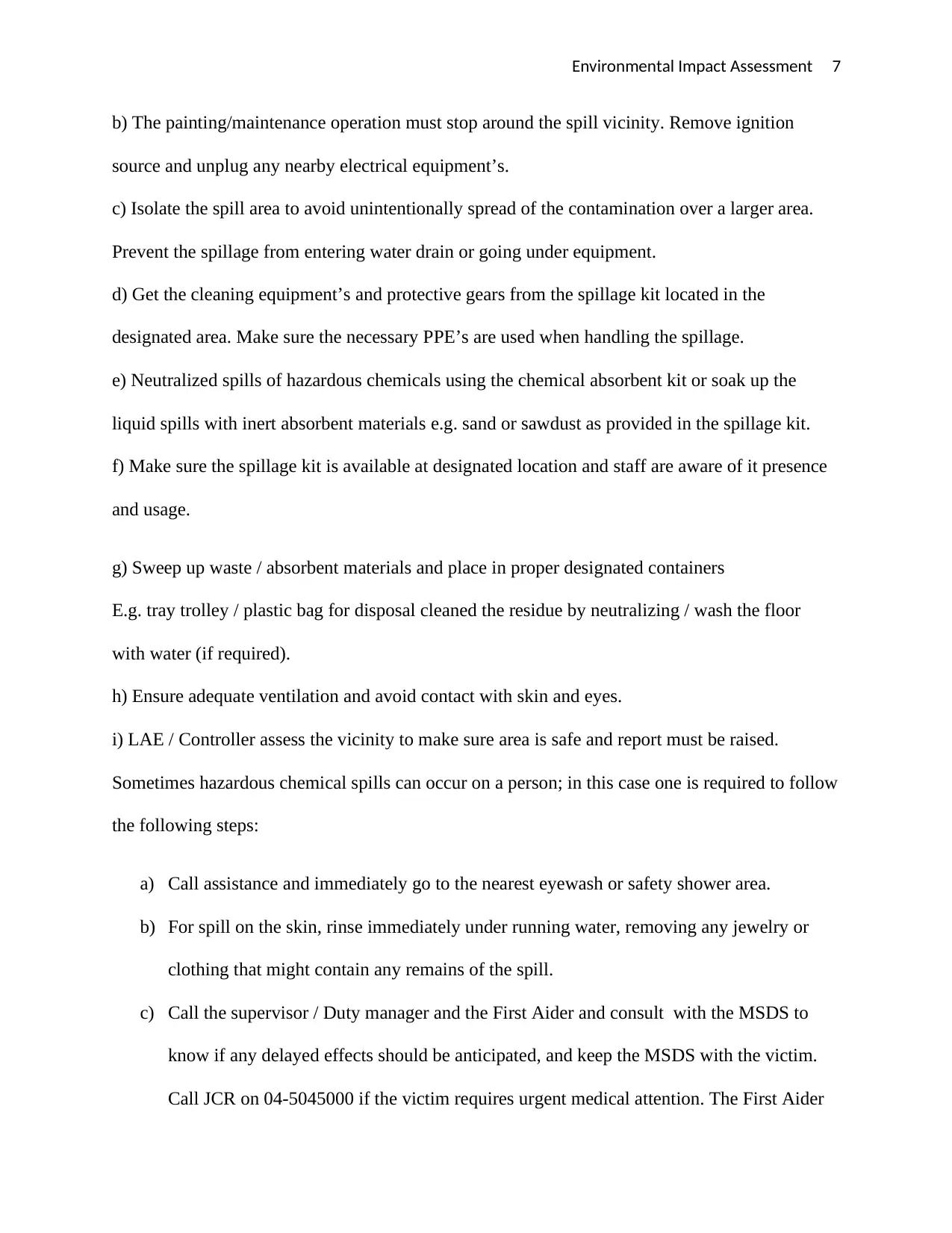
Environmental Impact Assessment 7
b) The painting/maintenance operation must stop around the spill vicinity. Remove ignition
source and unplug any nearby electrical equipment’s.
c) Isolate the spill area to avoid unintentionally spread of the contamination over a larger area.
Prevent the spillage from entering water drain or going under equipment.
d) Get the cleaning equipment’s and protective gears from the spillage kit located in the
designated area. Make sure the necessary PPE’s are used when handling the spillage.
e) Neutralized spills of hazardous chemicals using the chemical absorbent kit or soak up the
liquid spills with inert absorbent materials e.g. sand or sawdust as provided in the spillage kit.
f) Make sure the spillage kit is available at designated location and staff are aware of it presence
and usage.
g) Sweep up waste / absorbent materials and place in proper designated containers
E.g. tray trolley / plastic bag for disposal cleaned the residue by neutralizing / wash the floor
with water (if required).
h) Ensure adequate ventilation and avoid contact with skin and eyes.
i) LAE / Controller assess the vicinity to make sure area is safe and report must be raised.
Sometimes hazardous chemical spills can occur on a person; in this case one is required to follow
the following steps:
a) Call assistance and immediately go to the nearest eyewash or safety shower area.
b) For spill on the skin, rinse immediately under running water, removing any jewelry or
clothing that might contain any remains of the spill.
c) Call the supervisor / Duty manager and the First Aider and consult with the MSDS to
know if any delayed effects should be anticipated, and keep the MSDS with the victim.
Call JCR on 04-5045000 if the victim requires urgent medical attention. The First Aider
b) The painting/maintenance operation must stop around the spill vicinity. Remove ignition
source and unplug any nearby electrical equipment’s.
c) Isolate the spill area to avoid unintentionally spread of the contamination over a larger area.
Prevent the spillage from entering water drain or going under equipment.
d) Get the cleaning equipment’s and protective gears from the spillage kit located in the
designated area. Make sure the necessary PPE’s are used when handling the spillage.
e) Neutralized spills of hazardous chemicals using the chemical absorbent kit or soak up the
liquid spills with inert absorbent materials e.g. sand or sawdust as provided in the spillage kit.
f) Make sure the spillage kit is available at designated location and staff are aware of it presence
and usage.
g) Sweep up waste / absorbent materials and place in proper designated containers
E.g. tray trolley / plastic bag for disposal cleaned the residue by neutralizing / wash the floor
with water (if required).
h) Ensure adequate ventilation and avoid contact with skin and eyes.
i) LAE / Controller assess the vicinity to make sure area is safe and report must be raised.
Sometimes hazardous chemical spills can occur on a person; in this case one is required to follow
the following steps:
a) Call assistance and immediately go to the nearest eyewash or safety shower area.
b) For spill on the skin, rinse immediately under running water, removing any jewelry or
clothing that might contain any remains of the spill.
c) Call the supervisor / Duty manager and the First Aider and consult with the MSDS to
know if any delayed effects should be anticipated, and keep the MSDS with the victim.
Call JCR on 04-5045000 if the victim requires urgent medical attention. The First Aider
Paraphrase This Document
Need a fresh take? Get an instant paraphrase of this document with our AI Paraphraser
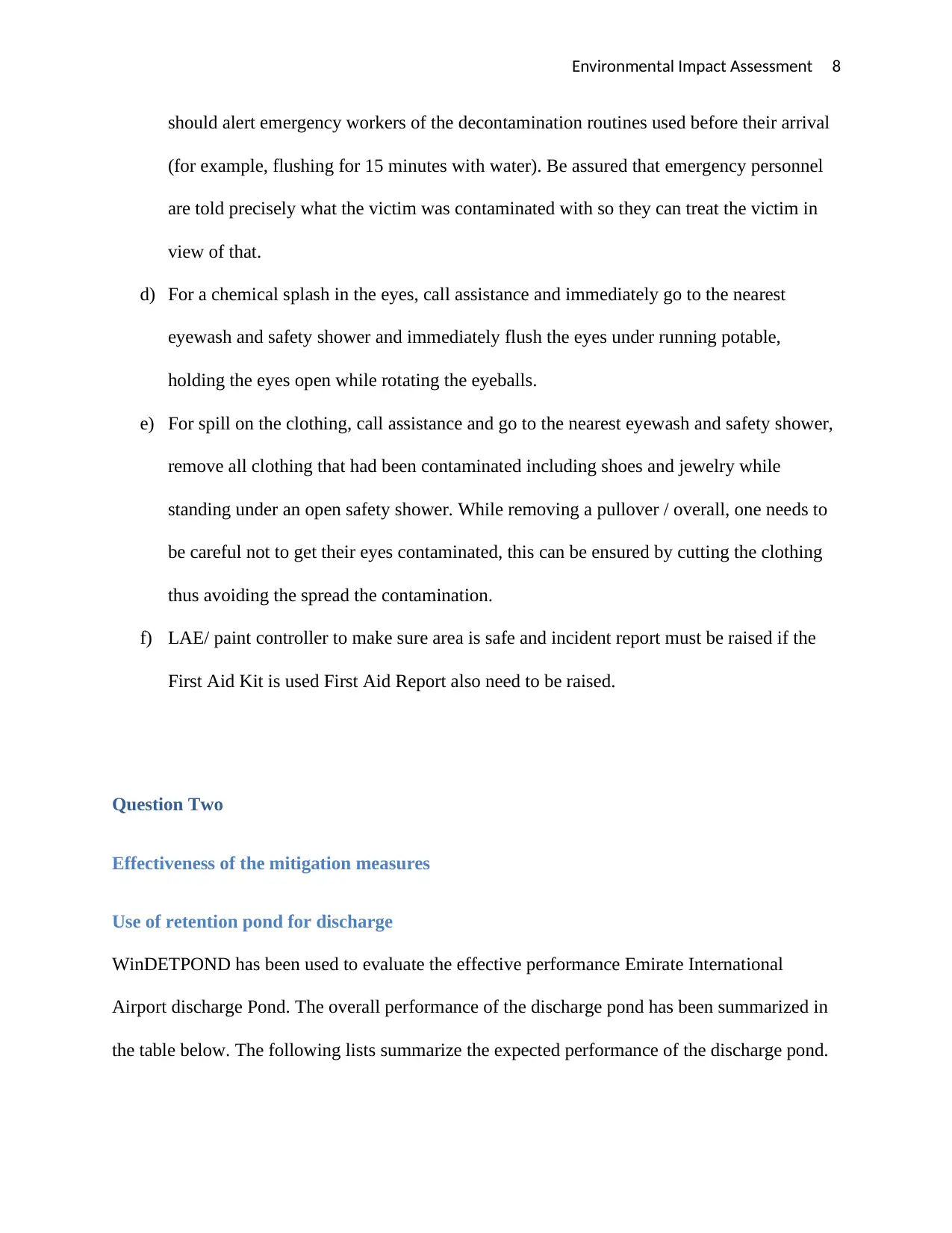
Environmental Impact Assessment 8
should alert emergency workers of the decontamination routines used before their arrival
(for example, flushing for 15 minutes with water). Be assured that emergency personnel
are told precisely what the victim was contaminated with so they can treat the victim in
view of that.
d) For a chemical splash in the eyes, call assistance and immediately go to the nearest
eyewash and safety shower and immediately flush the eyes under running potable,
holding the eyes open while rotating the eyeballs.
e) For spill on the clothing, call assistance and go to the nearest eyewash and safety shower,
remove all clothing that had been contaminated including shoes and jewelry while
standing under an open safety shower. While removing a pullover / overall, one needs to
be careful not to get their eyes contaminated, this can be ensured by cutting the clothing
thus avoiding the spread the contamination.
f) LAE/ paint controller to make sure area is safe and incident report must be raised if the
First Aid Kit is used First Aid Report also need to be raised.
Question Two
Effectiveness of the mitigation measures
Use of retention pond for discharge
WinDETPOND has been used to evaluate the effective performance Emirate International
Airport discharge Pond. The overall performance of the discharge pond has been summarized in
the table below. The following lists summarize the expected performance of the discharge pond.
should alert emergency workers of the decontamination routines used before their arrival
(for example, flushing for 15 minutes with water). Be assured that emergency personnel
are told precisely what the victim was contaminated with so they can treat the victim in
view of that.
d) For a chemical splash in the eyes, call assistance and immediately go to the nearest
eyewash and safety shower and immediately flush the eyes under running potable,
holding the eyes open while rotating the eyeballs.
e) For spill on the clothing, call assistance and go to the nearest eyewash and safety shower,
remove all clothing that had been contaminated including shoes and jewelry while
standing under an open safety shower. While removing a pullover / overall, one needs to
be careful not to get their eyes contaminated, this can be ensured by cutting the clothing
thus avoiding the spread the contamination.
f) LAE/ paint controller to make sure area is safe and incident report must be raised if the
First Aid Kit is used First Aid Report also need to be raised.
Question Two
Effectiveness of the mitigation measures
Use of retention pond for discharge
WinDETPOND has been used to evaluate the effective performance Emirate International
Airport discharge Pond. The overall performance of the discharge pond has been summarized in
the table below. The following lists summarize the expected performance of the discharge pond.
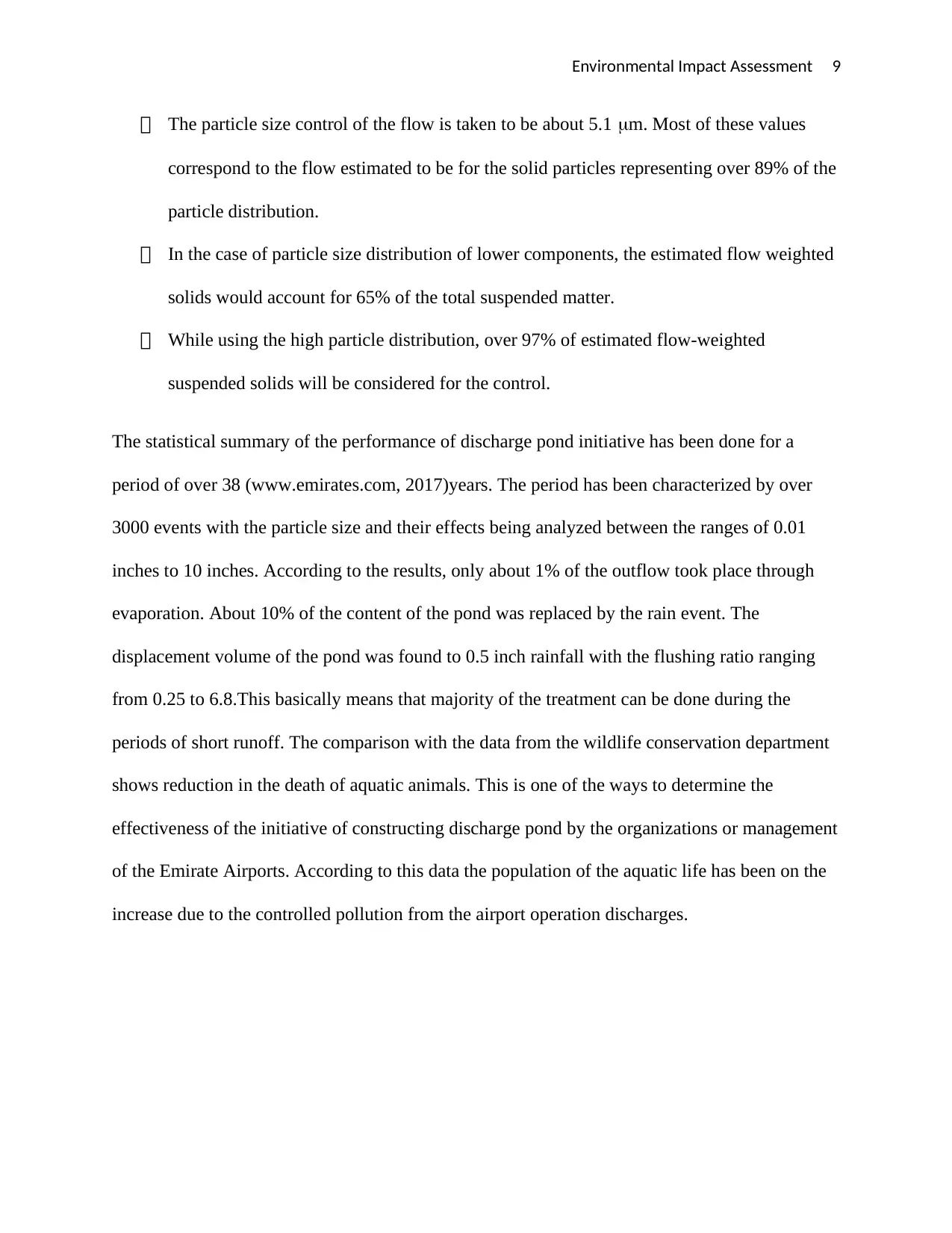
Environmental Impact Assessment 9
The particle size control of the flow is taken to be about 5.1 m. Most of these values
correspond to the flow estimated to be for the solid particles representing over 89% of the
particle distribution.
In the case of particle size distribution of lower components, the estimated flow weighted
solids would account for 65% of the total suspended matter.
While using the high particle distribution, over 97% of estimated flow-weighted
suspended solids will be considered for the control.
The statistical summary of the performance of discharge pond initiative has been done for a
period of over 38 (www.emirates.com, 2017)years. The period has been characterized by over
3000 events with the particle size and their effects being analyzed between the ranges of 0.01
inches to 10 inches. According to the results, only about 1% of the outflow took place through
evaporation. About 10% of the content of the pond was replaced by the rain event. The
displacement volume of the pond was found to 0.5 inch rainfall with the flushing ratio ranging
from 0.25 to 6.8.This basically means that majority of the treatment can be done during the
periods of short runoff. The comparison with the data from the wildlife conservation department
shows reduction in the death of aquatic animals. This is one of the ways to determine the
effectiveness of the initiative of constructing discharge pond by the organizations or management
of the Emirate Airports. According to this data the population of the aquatic life has been on the
increase due to the controlled pollution from the airport operation discharges.
The particle size control of the flow is taken to be about 5.1 m. Most of these values
correspond to the flow estimated to be for the solid particles representing over 89% of the
particle distribution.
In the case of particle size distribution of lower components, the estimated flow weighted
solids would account for 65% of the total suspended matter.
While using the high particle distribution, over 97% of estimated flow-weighted
suspended solids will be considered for the control.
The statistical summary of the performance of discharge pond initiative has been done for a
period of over 38 (www.emirates.com, 2017)years. The period has been characterized by over
3000 events with the particle size and their effects being analyzed between the ranges of 0.01
inches to 10 inches. According to the results, only about 1% of the outflow took place through
evaporation. About 10% of the content of the pond was replaced by the rain event. The
displacement volume of the pond was found to 0.5 inch rainfall with the flushing ratio ranging
from 0.25 to 6.8.This basically means that majority of the treatment can be done during the
periods of short runoff. The comparison with the data from the wildlife conservation department
shows reduction in the death of aquatic animals. This is one of the ways to determine the
effectiveness of the initiative of constructing discharge pond by the organizations or management
of the Emirate Airports. According to this data the population of the aquatic life has been on the
increase due to the controlled pollution from the airport operation discharges.
⊘ This is a preview!⊘
Do you want full access?
Subscribe today to unlock all pages.

Trusted by 1+ million students worldwide
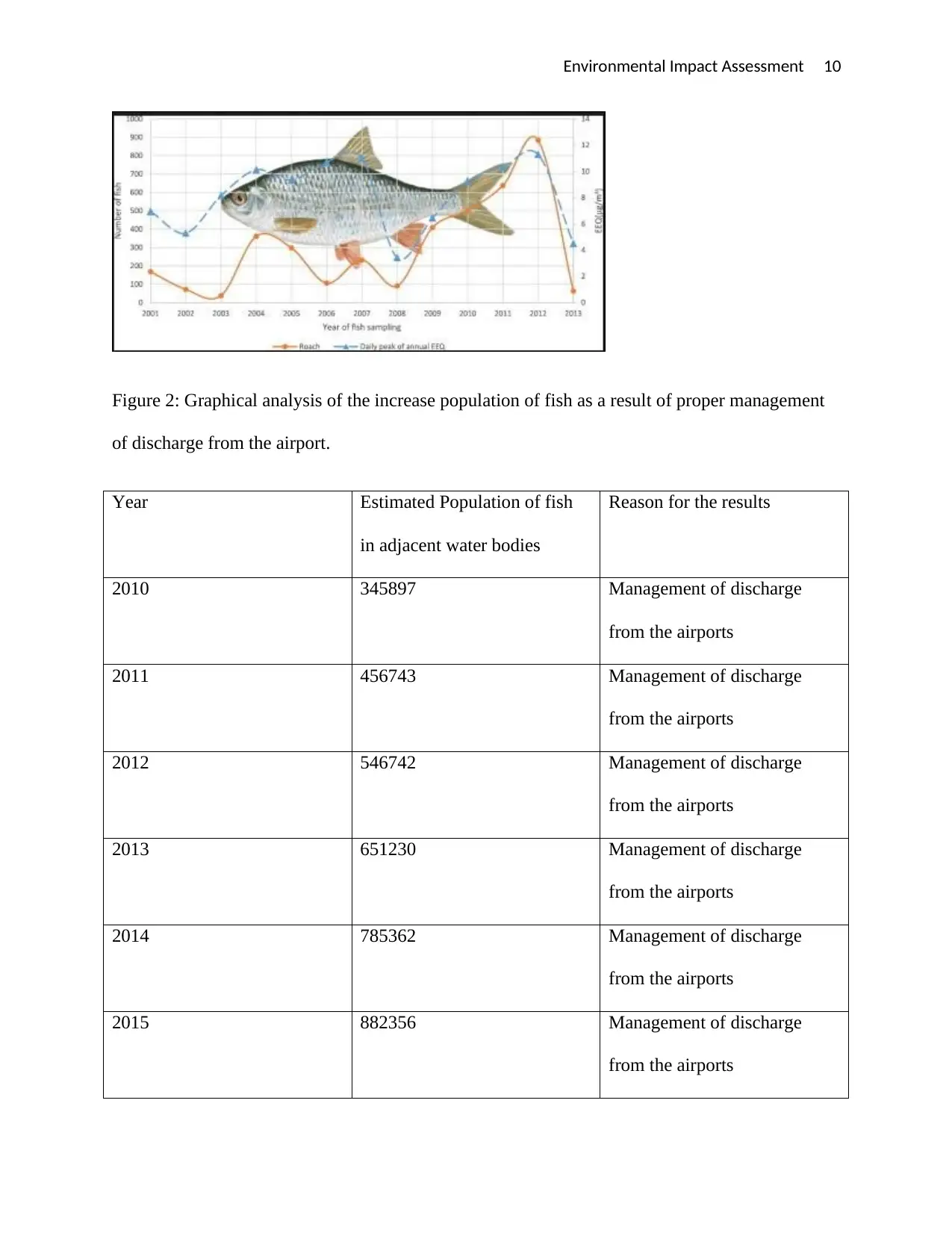
Environmental Impact Assessment 10
Figure 2: Graphical analysis of the increase population of fish as a result of proper management
of discharge from the airport.
Year Estimated Population of fish
in adjacent water bodies
Reason for the results
2010 345897 Management of discharge
from the airports
2011 456743 Management of discharge
from the airports
2012 546742 Management of discharge
from the airports
2013 651230 Management of discharge
from the airports
2014 785362 Management of discharge
from the airports
2015 882356 Management of discharge
from the airports
Figure 2: Graphical analysis of the increase population of fish as a result of proper management
of discharge from the airport.
Year Estimated Population of fish
in adjacent water bodies
Reason for the results
2010 345897 Management of discharge
from the airports
2011 456743 Management of discharge
from the airports
2012 546742 Management of discharge
from the airports
2013 651230 Management of discharge
from the airports
2014 785362 Management of discharge
from the airports
2015 882356 Management of discharge
from the airports
Paraphrase This Document
Need a fresh take? Get an instant paraphrase of this document with our AI Paraphraser
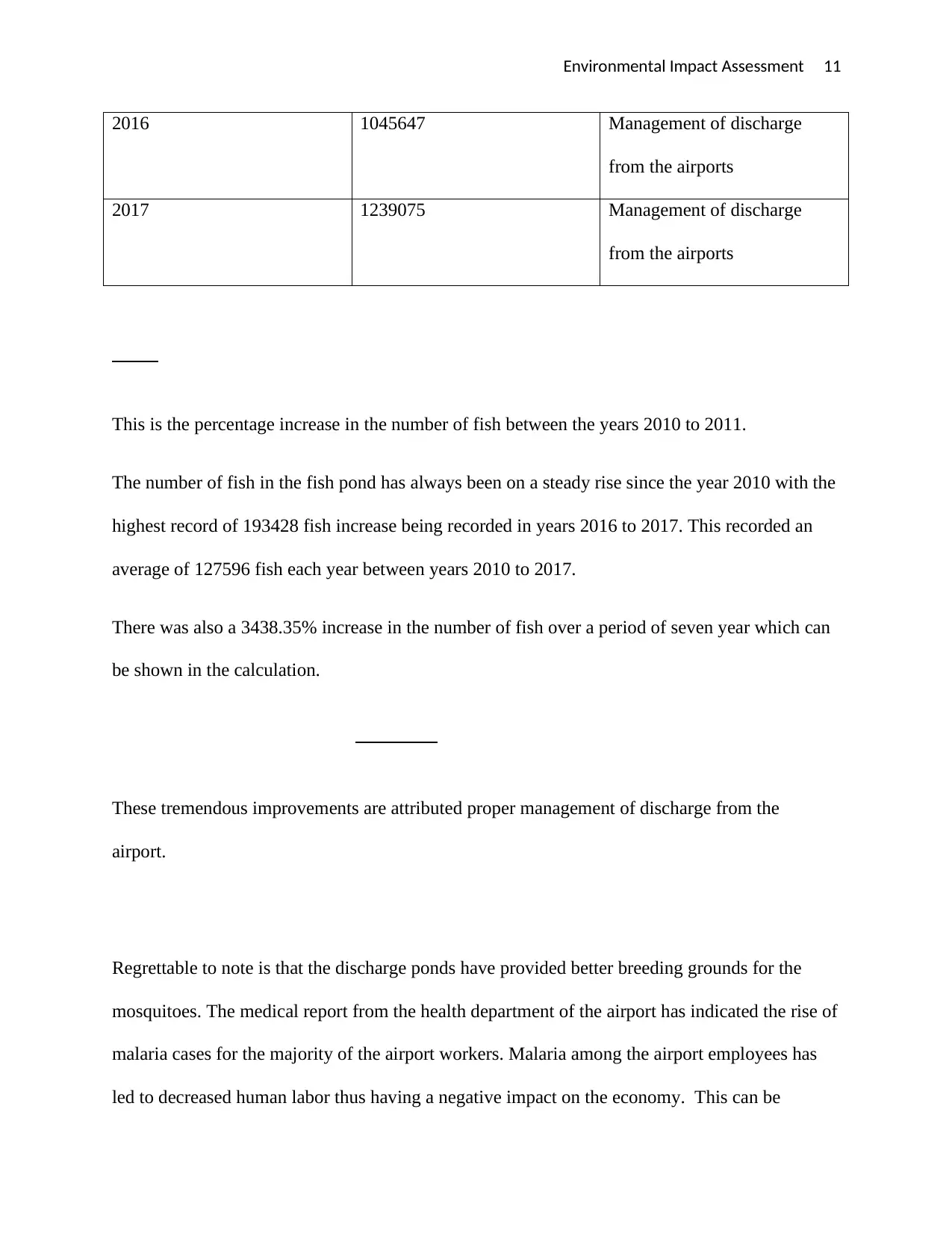
Environmental Impact Assessment 11
2016 1045647 Management of discharge
from the airports
2017 1239075 Management of discharge
from the airports
This is the percentage increase in the number of fish between the years 2010 to 2011.
The number of fish in the fish pond has always been on a steady rise since the year 2010 with the
highest record of 193428 fish increase being recorded in years 2016 to 2017. This recorded an
average of 127596 fish each year between years 2010 to 2017.
There was also a 3438.35% increase in the number of fish over a period of seven year which can
be shown in the calculation.
These tremendous improvements are attributed proper management of discharge from the
airport.
Regrettable to note is that the discharge ponds have provided better breeding grounds for the
mosquitoes. The medical report from the health department of the airport has indicated the rise of
malaria cases for the majority of the airport workers. Malaria among the airport employees has
led to decreased human labor thus having a negative impact on the economy. This can be
2016 1045647 Management of discharge
from the airports
2017 1239075 Management of discharge
from the airports
This is the percentage increase in the number of fish between the years 2010 to 2011.
The number of fish in the fish pond has always been on a steady rise since the year 2010 with the
highest record of 193428 fish increase being recorded in years 2016 to 2017. This recorded an
average of 127596 fish each year between years 2010 to 2017.
There was also a 3438.35% increase in the number of fish over a period of seven year which can
be shown in the calculation.
These tremendous improvements are attributed proper management of discharge from the
airport.
Regrettable to note is that the discharge ponds have provided better breeding grounds for the
mosquitoes. The medical report from the health department of the airport has indicated the rise of
malaria cases for the majority of the airport workers. Malaria among the airport employees has
led to decreased human labor thus having a negative impact on the economy. This can be
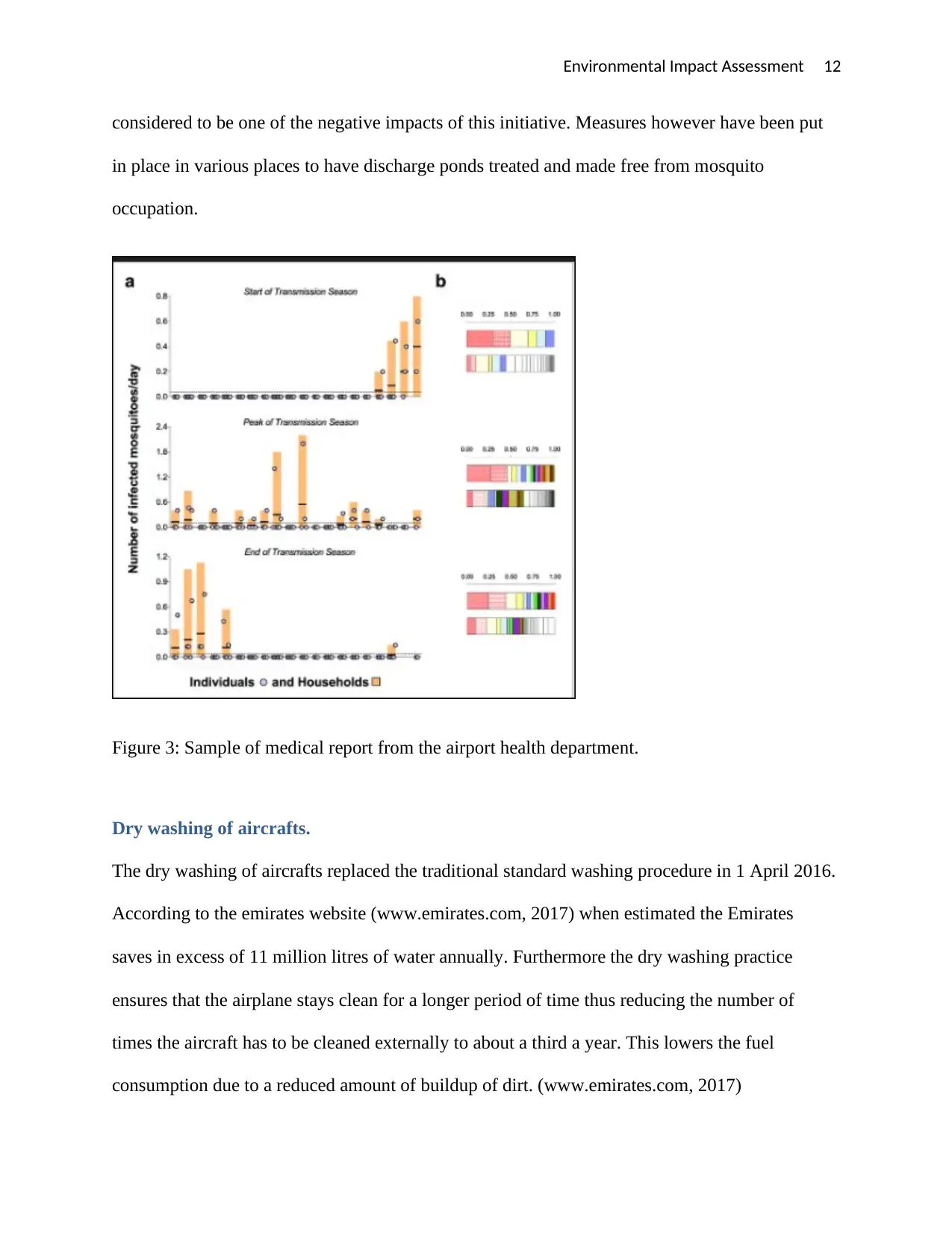
Environmental Impact Assessment 12
considered to be one of the negative impacts of this initiative. Measures however have been put
in place in various places to have discharge ponds treated and made free from mosquito
occupation.
Figure 3: Sample of medical report from the airport health department.
Dry washing of aircrafts.
The dry washing of aircrafts replaced the traditional standard washing procedure in 1 April 2016.
According to the emirates website (www.emirates.com, 2017) when estimated the Emirates
saves in excess of 11 million litres of water annually. Furthermore the dry washing practice
ensures that the airplane stays clean for a longer period of time thus reducing the number of
times the aircraft has to be cleaned externally to about a third a year. This lowers the fuel
consumption due to a reduced amount of buildup of dirt. (www.emirates.com, 2017)
considered to be one of the negative impacts of this initiative. Measures however have been put
in place in various places to have discharge ponds treated and made free from mosquito
occupation.
Figure 3: Sample of medical report from the airport health department.
Dry washing of aircrafts.
The dry washing of aircrafts replaced the traditional standard washing procedure in 1 April 2016.
According to the emirates website (www.emirates.com, 2017) when estimated the Emirates
saves in excess of 11 million litres of water annually. Furthermore the dry washing practice
ensures that the airplane stays clean for a longer period of time thus reducing the number of
times the aircraft has to be cleaned externally to about a third a year. This lowers the fuel
consumption due to a reduced amount of buildup of dirt. (www.emirates.com, 2017)
⊘ This is a preview!⊘
Do you want full access?
Subscribe today to unlock all pages.

Trusted by 1+ million students worldwide
1 out of 15
Related Documents
Your All-in-One AI-Powered Toolkit for Academic Success.
+13062052269
info@desklib.com
Available 24*7 on WhatsApp / Email
![[object Object]](/_next/static/media/star-bottom.7253800d.svg)
Unlock your academic potential
Copyright © 2020–2025 A2Z Services. All Rights Reserved. Developed and managed by ZUCOL.





